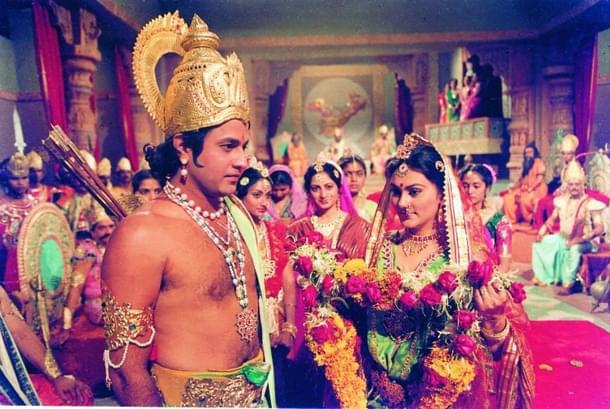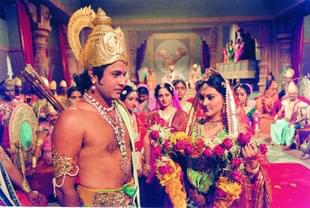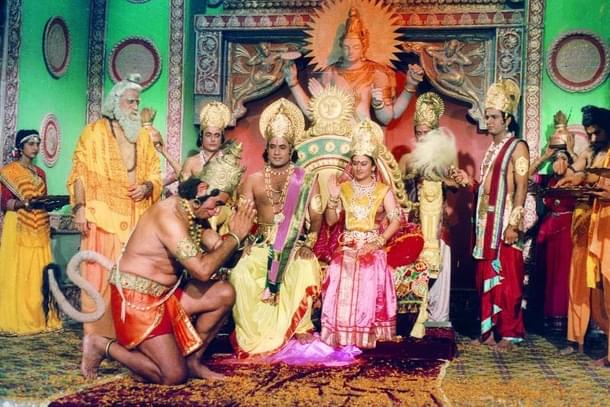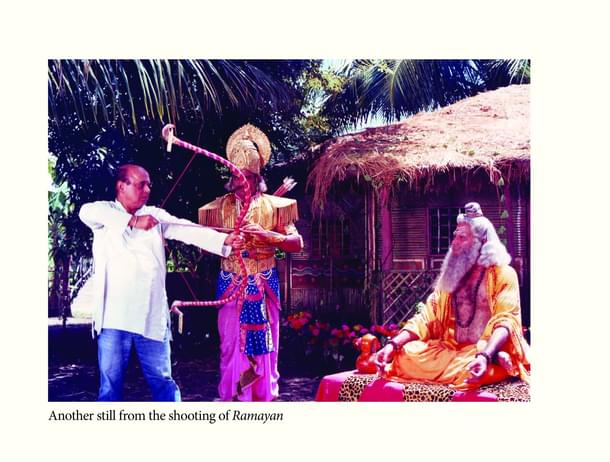Magazine
Doordarshan Brings Back Ramayan: How Ramanand Sagar Constructed A Tele-Kavya For The Ages
Prem Sagar
Mar 28, 2020, 10:04 AM | Updated 07:24 PM IST
Save & read from anywhere!
Bookmark stories for easy access on any device or the Swarajya app.


An Epic life: Ramanand Sagar: From Barsaat To Ramayan. Prem Sagar. Westland Publications. Pages 304. Rs 699.
Everyone took a casual suggestion to mean the prime minister wanted the Ramayana and the Mahabharata on DD. There was no time to spare, no tenders, no shortlisting.
Two Bombay filmmakers, Ramanand Sagar and B.R. Chopra, were asked to immediately produce the epics. Rajiv Gandhi had asked for Ramayan! That is how the biggest moment in Indian television came about.
However, adversities never left Papaji. There was a continuous barrage from the press and the bureaucrats criticising the show and wanting to get the telecast truncated as early as possible, even during its unprecedented success as a cult classic.
Bhaskar Ghose refused to give Papaji an additional twenty-six weeks so that the show could be stopped midway. But the addiction to Ramayan in the country was so strong that if it had stopped, the whole country would have been hurt.
Despite Ghose’s many efforts, the broadcast of the show did not stop. Papaji sought permission to continue with it, directly from H.K.L. Bhagat, who was the I&B minister at that time.
Ghose’s dictatorship still did not end. He told Papaji that by reducing the Hindu element in Ramayan, it could be made a little more secular so that it could be watched by diverse viewers.
This meant that there was no unity among the Hindus, and their ascendancy could be in danger. But Papaji did not give up, despite all these conspiracies by Ghose. Nor did he agree to any kind of compromise in his direction of the show which he felt could not be stopped or changed.
He was smart enough to send the video tapes to Ghose just at the time when there were only few hours left for the broadcast. Despite all the negativity, Ramanand Sagar had delivered the show with complete honesty.
Papaji had barely nine days before the telecast of Ramayan on 25 January 1987. The almost-impossible, Herculean job was to find a studio, erect sets, get costumes, etc.
During the making of Vikram aur Betaal, I had worked very closely with Hirabhai Patel, the famous art director of yesteryears. He had ingenious ideas like miniature palace roofs, entire sets in miniature with background paintings and other cinematic tricks.
I had managed to shoot the entire serial Vikram aur Betaal in Sagar Villa itself. As a classic costume drama, the script had required palaces, a set resembling the Mahakaal in Ujjain, etc., but the legendary Hirabhai, who had done a lot of mythological shows and fantasies for Wadia Movietone, managed all kinds of settings required on a shoestring budget.
Hirabhai was the owner of the abandoned sprawling Vrindavan Studios in Umargaon, Gujarat. The moulded palace pillars, thrones and settings were ready, all just waiting to be assembled.
The creaking doors were opened, the cobwebs cleared and Hirabhai’s Vrindavan Studios and Umargaon were about to enter the pages of history.
An unknown small sleepy town, Umargaon, on the shores of Gujarat, would soon be recognised globally and find its place of pride on the world map. Even the BBC would speak about it.
Papaji concentrated on the writing and research; Anand was the creative director; Moti took charge of editing; Subhash was in charge of production and I was in charge of technical matters, including camera, special effects and graphics.
The team worked in total coordination. The star cast of Vikram aur Betaal, now in Ramayan, was a perfectly well-coordinated one — whether it was Ram, Sita, Lakshman or Hanuman.
Sawant Dada and his team, who had earlier worked on multiple mythological episodes and fantasies with the Wadia brothers, were in charge of the make-up department.
On the morning of 25 January 1987, the first episode of Ramayan was telecast at 9 am to the whole nation. Papaji and his entire family and staff watched it quietly, sitting on the Persian blue carpeted floor of his bedroom.
When the episode ended, there was pin-drop silence for a few minutes, and then the entire room echoed with claps. Despite all the hurdles, Papaji’s Ramayan was now a reality.
Week after week, for seventy-eight weeks, Ramayan was telecast without a break or hurdle, no one fell sick, the tapes reached Delhi, at times minutes before the telecast, which was by itself a miracle.

Over a hundred unit members, technicians, actors and workers slept in shifts, at times just for a few hours, to complete the shooting and post-production in time.
Day and night, the Bombay-Umargaon route had cars plying and trains loaded with the Ramayan team. Strictly no air travel was allowed, neither for the boss nor for the actors.
There were no call sheets or schedules. All actors were on twenty-four-hour red alerts. If Papaji finished writing a scene at 3 am, the actors immediately got ready with their make-up and costumes and shooting began.

There were no shift timings, as it was round the clock. Actors like Dara Singh spent three to four hours in the make-up room. The Hanuman look—with his foam rubber-moulded mouth— involved painstaking effort and was time-consuming.
Hundreds of junior artists had to get ready. In the mass monkey scenes, local ideas were adopted—coconut shells with a marble strung between the cut edge to hold between the teeth in the mouth. They were called ‘goti bandars’ or ‘marble monkeys’.
During the shot, they were instructed to hold the marble, and a hundred monkey soldiers would be ready in a jiffy. Sawant Dada worked his make-up magic on everyone, be it the gods or the demons.
The pressure of writing weighed very heavily on Papaji. Imagine writing day and night, scene after scene, sometimes on the set itself, while the shoot was on. The responsibility was immense as the viewership was huge and cut across all social strata.
I remember praying in the Hanuman temple at Connaught Place, Delhi. Once, Papaji felt as if a copper statue of Hanumanji in the opposite shop was speaking to him. He just walked across and bought the statue, without even bargaining.
After that, he would tell me that whenever he had writer’s block, he would talk to the statue kept in his private room about what the dialogues should be. Papaji told me that Hanumanji would ‘speak’ to him and sometimes even narrate the dialogues required for the scene.
As I recall, on 1 January 2003 Papaji met Ashok Singhal, chief of the Vishva Hindu Parishad (VHP), at Sagar Villa. Both of them exchanged their experiences of miracles during the making of Ramayan.
Papaji confided in him about how he had been worried and burdened with self-imposed responsibilities. Early one morning, a sadhu came to Sagar Villa. Papaji was on the terrace with my mother, feeding the pigeons.
It was a normal practice for many sadhus to come home or to our office at Natraj Studios. They were all treated with reverence. Some would want a rail ticket, and others, a blanket, and so on.
If they appeared genuine, their requests were complied with, and if anything was found suspicious about them, they would still be given a ten-rupee note, because Papaji always believed that a sadhu should never be returned empty-handed.
That day, instead of my mother, Papaji decided to meet the sadhu.
He was a very young sadhu and had a brilliant aura around him. Papaji asked him how he could help him. He said that he had come to give him a message from his guru in the Himalayas.
Suddenly, to Papaji’s shock, the tone and volume of the sadhu changed into that of a command, “Who are you? What is this pride—I will not do this … I will not do that! What do you think … you are making the Ramayan! Why are you worried?
“In the upper spiritual world, there is a yojana vibhag (planning commission). India is going to lead the world and a few of you have been sent to create awareness. Do your work and come back …’ The divine-looking sadhu did not look back, and walked straight out of Sagar Villa.
After that day Papaji knew Ramayan was being written and executed by higher powers, and he was only an instrument.
One such example to support this feeling was the sequence in Ramayan in which Bharat, Ram’s brother, refuses the throne. The entire sequence had been shot and canned.
Late at night, Papaji got an inspiration to redo it to make it more contemporary and relevant. Before King Dashrath in his royal court, his council of ministers and the praja (people), Bharat first analyses that there are three affirmations required to crown a king.
The vote of the people, the approval of the gurus and the acceptance of the king to crown his next heir. In the case of Ram, all three conditions were fulfilled. Why, then, was he sent to exile for fourteen years?
If you have a right to vote, it is your duty to protect this right. Surprisingly, no one rebelled when Ram was banished, to live in the forest for fourteen years.
In such cases, where you do not protect your rights, other factors like palace intrigues and secret plots will be forced and dumped on the citizens and the country. This was a commentary on the dynastic family rule prevalent in Delhi.
Prem Sagar is director-producer and cinematographer. Closely associated with the show ‘Ramayan’, Sagar went on to have an extremely successful career in television being associated with shows like ‘Shri Krishna’, ‘Sai Baba’, ‘Prithviraj Chauhan’ and ‘Chandra Gupta Maurya’ in various creative capacities.





